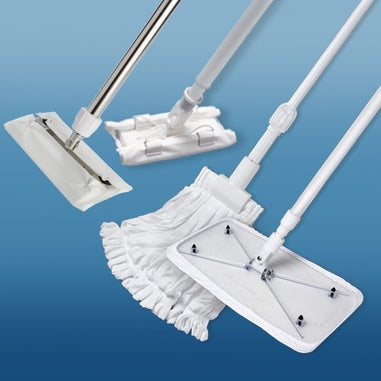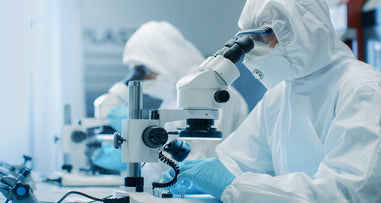- No products in the cart.
What is a Class 100 Cleanroom?
An ISO 5 class cleanroom, also known as a class 100 cleanroom, only allows 100 particles of size 0.5 µm or larger per cubic ft. (100,000 particles/ per m³) of air. This classification is on the more critical end of the spectrum and requires a high level of filtration. Even to enter a class 100 requires passage through other ISO controlled environments.
Manufacturing industries that might need class 100 cleanrooms include aerospace, optical, semiconductor, solar, waferboard, recording media, and implantable medical devices. For a successful startup of a well-designed ISO 5 cleanroom, pre-planning, procedural implementation, and understanding systems engineering are crucial components. Ensure that you have the tools you need for your Class 100 cleanroom by visiting Lab Pro’s Cleanroom Manufacturing page.

ISO 5 Cleanroom Classifications
The naming for ISO classroom identifications (ISO standard 146144-1:2015) are based on the decimal logarithm of the number of permissible particles ≥ 0.1 µm or larger per m3 of air, while the numbered classes of Federal Standard 209E indicate the number of permissible particles ≥ 0.5 mm/ft3 of air.
In an ideal scenario, to achieve ISO 5 air cleanliness, you must enter the cleanroom via an ISO 8 (ante-room), then pass through an ISO 7, followed by an ISO 6 before entering. While that is not always feasible, regulations require that two connected rooms should be no more than two orders of magnitude difference in cleanliness class.
Class 100 cleanrooms and cleaner facilities employ the use of laminar, or unidirectional, airflow to remove airborne adulterants. The air sweeps down the room in one direction at 0.3 - 0.5 m/s and departs through the floor. Ultra Low Penetration Air (ULPA) Filtration is 99.9995% efficient, removing airborne particles up to 0.12 micron.
Airborne Particulate Cleanliness for Class 100 Cleanroom
|
Micron |
0.1 |
0.2 |
0.3 |
0.5 |
1 |
5 |
|
Particles/m3 |
100,000 |
23,700 |
10,200 |
3,520 |
832 |
29 |
Schedule of Tests to Demonstrate Continuing Compliance
|
Test Parameter |
Class |
Maximum Time Interval |
Test Procedure |
|
Particle Count Test |
<= ISO 5 |
6 Months |
ISO 14644-1 Annex A |
|
Air Pressure Difference |
All Classes |
12 Months |
ISO 14644-1 Annex B5 |
|
Airflow |
All Classes |
12 Months |
ISO 14644-1 Annex B4 |
Federal and ISO Airflow Velocity Standards
|
Class: ISO 146144-1 (Federal Standard 209E) |
Average Airflow Velocity (m/s (ft/min)) |
Air Changes Per Hour |
Ceiling Coverage |
|
ISO 5 (Class 100) |
0.203 – 0.406 (40 – 80) |
240 – 480 |
35 – 70% |
Garments
The American "Institute of Environmental Sciences and Technology" (IEST) recommends the following clothing for Class 100 (ISO5) cleanrooms.
- Hair cover
- Hood
- Face mask (2X)
- Coverall
- Boots
- Protective gloves
Source: IEST - Garment System Considerations for Cleanrooms and Other Controlled Environments.
- You may also need to stock bouffants, beard covers, goggles, glove liners, booties, and shoe covers in your Class 100 cleanroom.
To minimize contamination of particulates in your ISO 5 cleanroom, only non-shedding cleanroom PPE is permitted. They are typically made of Gortex, Tyvek, Dacron or other nonwoven material like polypropylene or other microporous materials. Lab Pro stocks a wide variety of sizes and styles of garments suitable for your Class 100 cleanroom.
Coverall
- Dacron cleanroom coverall
- Advantage Pro polypropylene cleanroom coverall
- Coverall with hood and boot
- Microporous coverall
- ISO Class 6 cleanroom Tians high performance coverall with hood & zipper
- Latex/free film coated coverall for use in critical and low particulate clean environments
- Suitable for exposure to bloodborne pathogens, some hazardous liquids, and where liquid splash is a concern
- Static dissipative polyethylene/propylene fabric with ≤1011 surface resistance
- Attached hood, zipper front entry, elastic wrists, elastic ankles, elastic lower back, and a storm flap zipper cover, serged seam construction
- Although this coverall is really cool, it says ISO 6 which isn’t clean enough?
Bouffant
- Low-linting polypropylene bouffant caps
Beard Cover
- Latex-free beard covers
Face Mask
- 3ply disposable non-woven fiber fabric face masks
Gloves
ISO 5 or Class 100 gloves are ISO and FED STD 209E rated. These bagged gloves have been treated to be free of microorganisms and are powder-free. They are discarded after one use.
Shoe Cover
- LabClean Shoe Covers are made of 100% spun bond polypropylene and are non-skid
Gowning Area
Set up the gowning area for easy access to cleanroom garments.
- Tacky mats are needed at the entrance of a gowning room to remove particulates from before entering.
- Have shoe covers available to don after stepping on the tacky mats and before entering the gowning room.
- Setup up a garment supply area with frocks and gowns on one side and a separate shelf for hoods, masks, and other supplies. Metro garment racks are made of industry compliant stainless steel and are built for cleanliness and stability. Some storage cabinets are equipped with HEPA filtration to whisk away unwanted particles.
- Use an easy-to-clean gowning bench to don coverall. Have sterile wipes available for cleaning the bench after each use.
- Demarcate the clean/dirty floor with cleanroom tape. 5S systems can help improve efficiencies in cleanrooms.
- Only laundered booties are allowed in designated clean area (which is frequently cleaned with a fresh, nonwoven mop).
In the Cleanroom - Office Supplies
Everyday items such as pen, notepads, and paper are unsuitable for cleanroom settings. Lap Pro stocks the sundries you need for cleanroom recordkeeping.
- Cleanroom notebooks
- Cleanroom paper and sticky notes
- Cleanroom pen (this says microscope parts and accessories??)
In the Cleanroom - Tools and Equipment
Lab Pro sells a wide variety of devices that are especially designed for use in cleanrooms.
- Yamato Class 100 ovens for use in your ISO 5 cleanroom
- Tools like tweezers, forceps, pliers, brushes, and hemostats
- Cleanroom swabs
- Cleanroom vacuum systems
- Cleanroom razor blade
- Metro microban dunnage racks and utility carts are rust and mildew
- Meters and monitors
- Racks, shelving, boxes, and bins
- Thermal holding and transport
- Trashcans and liners
Cleanroom Chemicals
Cleaning
- Sealed-edge polyester wipes are perfect for ISO 5 or Class 100 cleanrooms because the edges don’t shed. Stay away from polycellulose or nonwoven wipes for this classification.
- Coventry cleanroom polyester wipes offer the highest level of protection because they have been laundered in a Class 10 (ISO Class 4) cleanroom to remove particles.
- Chemtronics Coventry poly-onyx ESD wipes are class 100 – 1000 (ISO 5-6) black, laser-sealed edge polyester wipe that are static dissipative within 107-109 range for S20.20 compliance.
- Chemtronics Coventry hi-purity polyester alcohol wipes are saturated with semiconductor grade isopropyl alcohol (IPA) filtered through 0.05 µm media. They are class 10 (M3, ISO 4) cleanroom processed and packaged and ideal for cleaning semiconductor wafer fabs and other critical applications.
- Chemitronics Coventry cleanroom chamoix for removing solder flux
Cleanroom Testing
- Chemtronics foam or flocked sampling swabs
Considerations for Class 100 (ISO 5) Cleanrooms
Maintaining the cleanliness of your cleanroom is the most important aspect of the job. An ISO 5 classification has high standards of hygiene because customer safety depends on it. Before introducing any items into a Class 100 environment, check and label as compatible. Keep on the lookout for regulation changes and new products that come into the shop at Lab Pro.
Note: These products and chemicals are meant to be used for research, industrial work, cleaning or disinfecting and should always be stored out of the reach of young children or infants.
For over 40 years, Lab Pro Inc. has been committed to delivering the highest quality chemicals, ESD protection, laboratory and cleanroom supplies to medical device and electronic manufacturing laboratories worldwide. To learn more, visit the biggest Lab Supply showroom in California, or contact us online or at 888-452-2776.












































